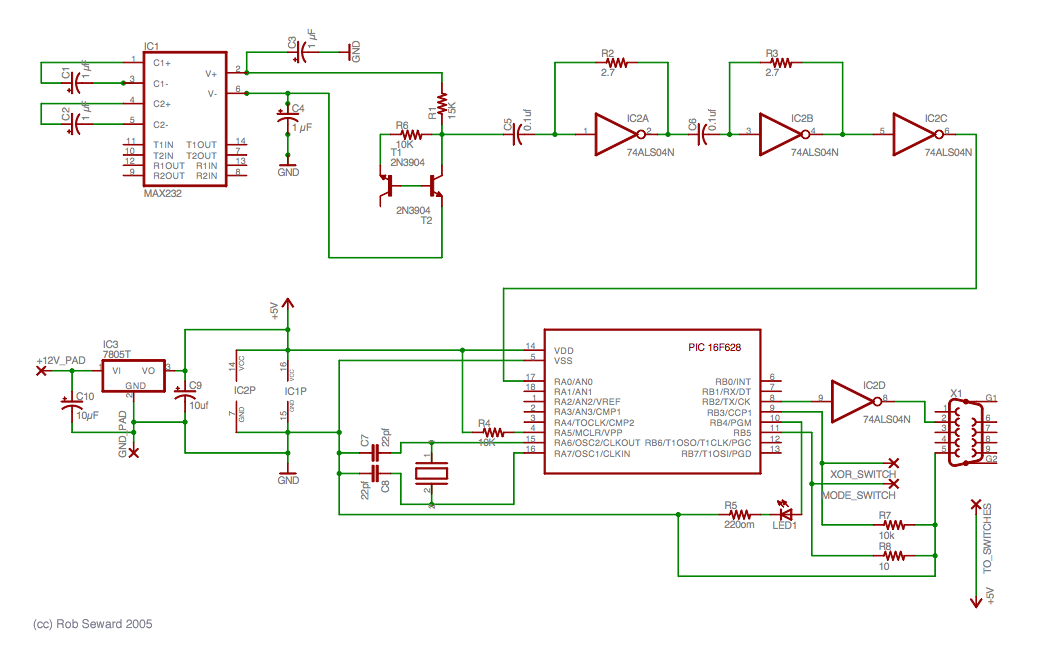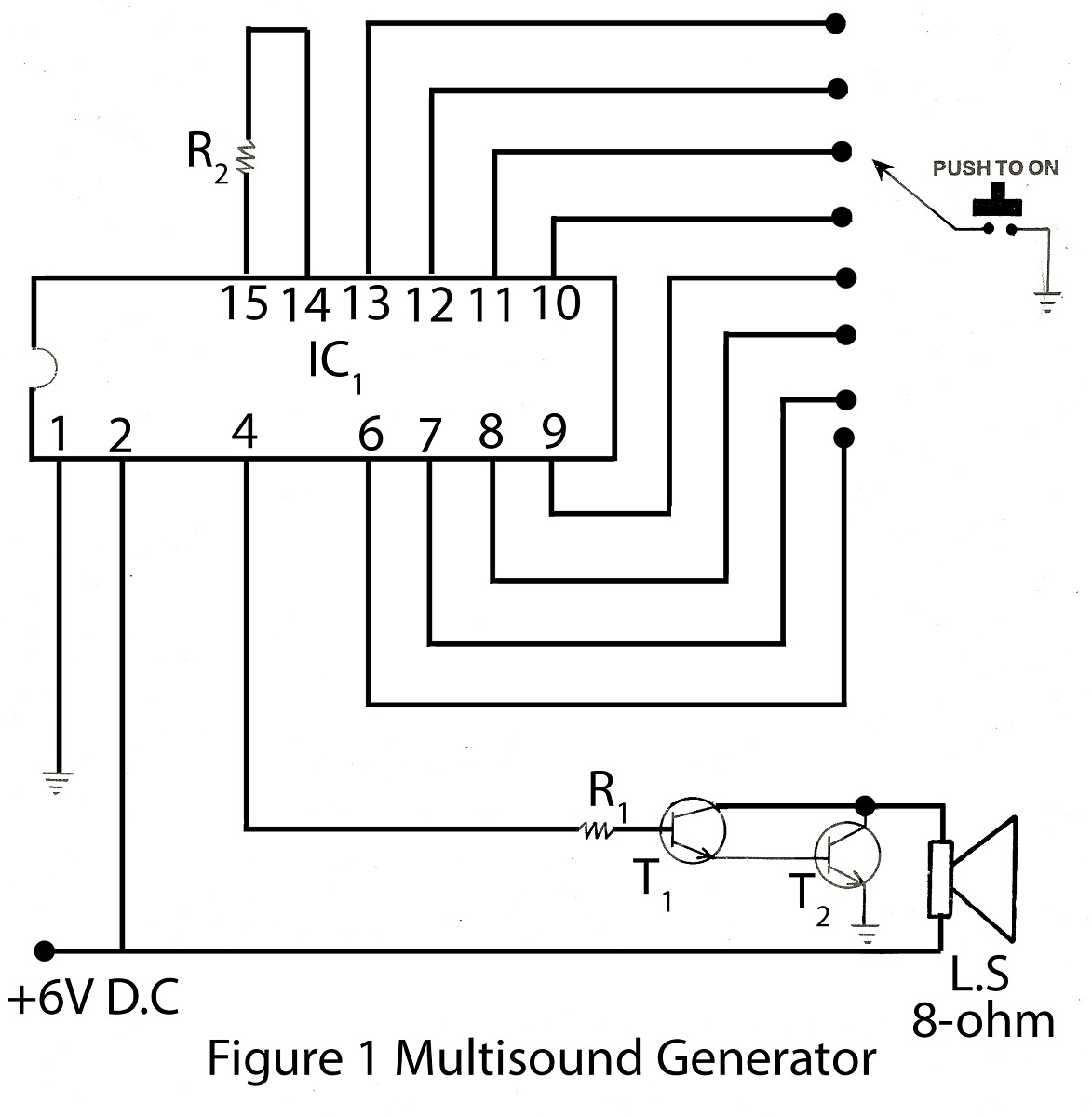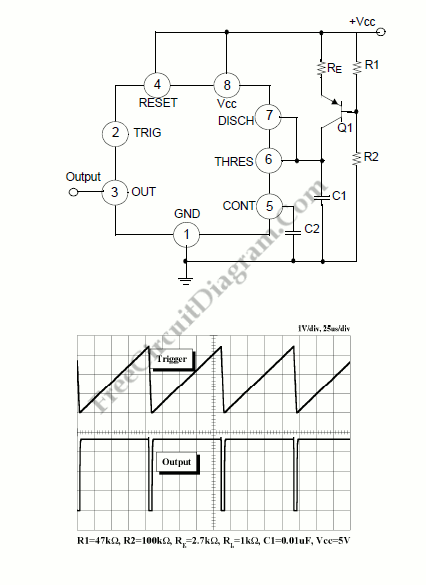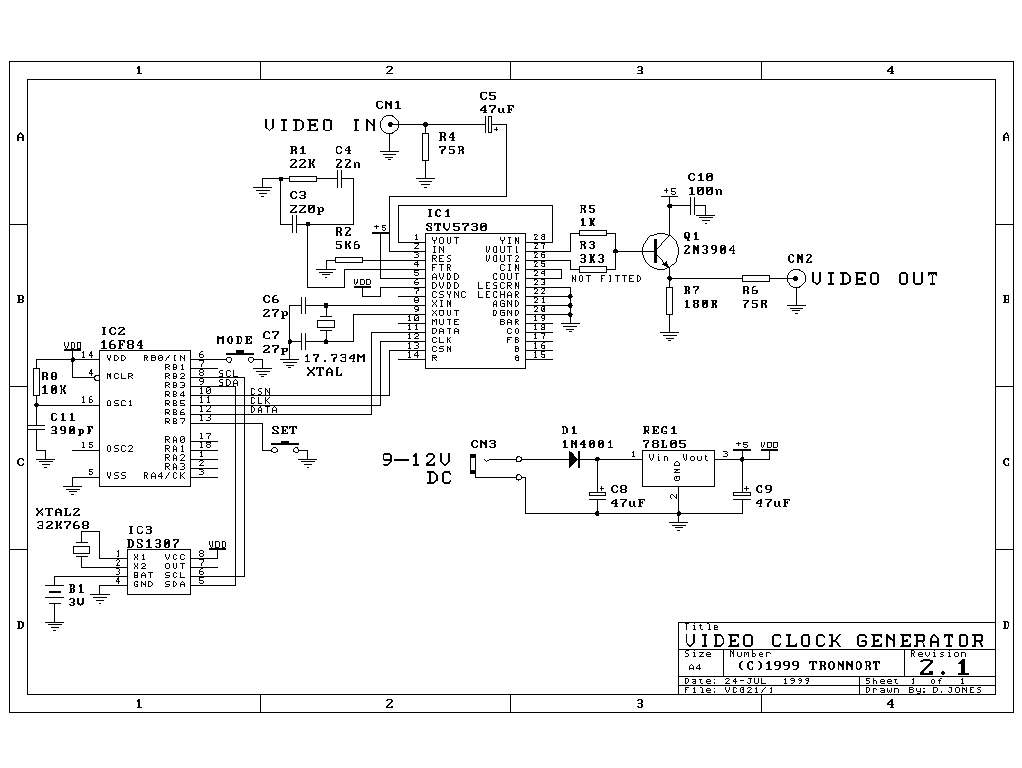
random generator

This generator utilizes avalanche noise and is based on a design by Will Ware. It provides instructions for using a PIC chip to analyze a noise source and output random data serially. Circuit diagrams and links for fabricating a custom board are included. There are two types of random numbers: true and pseudo. Pseudo-random numbers are generated by an algorithm, which can be predictable if the algorithm is known. True random number generators produce sequences that are inherently unpredictable, using random physical phenomena as their source of randomness. This circuit employs avalanche noise from a reverse-biased PN junction, specifically the emitter-base junction of the first transistor. The second transistor amplifies the signal. The first two ALS04 inverters are biased into a linear region, functioning similarly to operational amplifiers for further amplification. The third inverter amplifies the signal additionally. The PIC chip analyzes the noise and outputs random bits, specifically a 16F648A model that includes a comparator. The input signal to the PIC experiences noise fluctuations between 1 and 2 volts, with spikes reaching up to 3 volts. These spikes are the focus of measurement. The comparator filters out noise and interrupts the PIC whenever a spike occurs, as it has been found to be more responsive than the PIC's ADC. The PIC code records the number of detected spikes within a short time frame; an even number of spikes results in a output of 1, while an odd number yields a 0. The board also accommodates two switches that control the output mode and the XOR mask. The mode switch allows the generator to output either random bytes or ASCII 1's and 0's. The XOR mask combines the generator's output with a string of alternating 0's and 1's to reduce bias, with a switch to enable or disable this feature. The board is created using a laser-printer transfer technique. Instructions for this process will be provided later, but existing guides are referenced: Concise, Verbose, and Mine. It is recommended to read the Concise guide first for an overview, followed by the Verbose guide for detailed instructions, particularly regarding the ironing step, which is critical for successful toner transfer. Additionally, filling open areas with shapes on the board is advised to minimize exposed copper during etching, thus reducing etchant usage and etching time. The components should be inserted through the holes on the non-copper side of the board and soldered in place. The board requires a 12V power supply, connected to +12V and GND holes, but it can also operate with a 9V battery. As of December 14, 2005, extensive analysis of the output has not yet been conducted, but preliminary results show a histogram of the random bytes appears satisfactory, with a balanced ratio of 0's to 1's. Approximately one million bits without the XOR mask were tested with the NIST test suite, passing about 75% of the tests. Future attempts will include the XOR mask to assess any improvements.
The generator circuit leverages the inherent unpredictability of avalanche noise, which is generated in a reverse-biased PN junction, to produce true random numbers suitable for applications requiring high levels of security, such as encryption. The circuit's architecture begins with a transistor that captures the avalanche noise, which is then amplified by a second transistor. Following this, two ALS04 inverters are employed in a biased linear configuration, functioning as operational amplifiers to further enhance the signal strength before passing it to a third inverter for additional amplification.
The PIC 16F648A microcontroller plays a crucial role in this setup. It is equipped with a comparator that effectively filters the noise signal, allowing the microcontroller to detect significant voltage spikes indicative of random noise events. The comparator's rapid response time is critical in ensuring that no spikes are missed, which is essential for generating a reliable stream of random numbers. The software running on the PIC is designed to count the number of detected spikes in a specified time interval, translating this count into binary output based on parity—outputting a '1' for even counts and a '0' for odd counts.
The inclusion of switches for output mode selection and an XOR mask enhances the versatility of the generator. The output mode switch allows users to choose between different formats of random data, while the XOR mask serves to mitigate any inherent bias in the output, ensuring a more uniform distribution of bits. This capability is particularly important in cryptographic applications where predictability can lead to vulnerabilities.
The fabrication process of the circuit board involves careful attention to detail, especially in the toner transfer method, which is sensitive to the ironing technique used. The recommendation to fill open areas with shapes is a practical approach to reduce the amount of exposed copper during etching, thereby optimizing the etching process. The final assembly of the components is straightforward, with clear guidelines for soldering and power connections, ensuring that the circuit operates reliably with the specified power sources.
The initial testing results indicate the generator's efficacy, with a good distribution of random bytes and a favorable pass rate in the NIST test suite. Further testing with the XOR mask is anticipated to enhance the performance of the generator, providing a robust solution for applications requiring true random number generation.This generator uses avalanche noise, and is based on a design by Will Ware. Herein are instructions as to how you can use a pic chip to analyze a noise source and output random data serially. I`ve included circuit diagrams as well as links to instructions for fabricating your own board. There are two types of random numbers: true and pseudo. Pseu do random numbers are created by an algorithm. The problem with this is that if someone knows what algorithm you use, it is theoretically possible predict what numbers you will create. True random number generators create sequences that are impossible to predict. They use random physical phenomenon as their source or randomness. They are used for encryption and micro psychokinesis research. "This circuit uses avalanche noise in a reverse-biased PN junction, the emitter-base junction of the first transistor.
The second transistor amplifies it. The first two ALS04 inverters are biased into a linear region where they act like op amps, and they amplify it further. The third inverter amplifies it some more. " The Pic chip is for analyzing the noise and sending out random bits. I used a 16F648A because it has a comparator. The signal going into the pic has fuzz between 1 and 2 volts and spikes that go up to 3 volts. It`s these spikes we want to measure. The comparator will cut out the fuzz and interrupt the pic whenever there is a spike. (I tried the pic`s ADC but the comparator seemed more responsive). The pic code works like this: the pic records the number of spikes it detects in a short time interval.
If there are an even number of spikes it outputs a 1, an odd number a zero. Also, the board has input for two switches. These control the output mode and the XOR mask. The mode switch sets the generator to output either random bytes or ascii 1`s and 0`s. The XOR mask XOR`s the output of the generator with a string of alternating 0`s and 1`s. This reduces bias. The switch turns the mask on or off. To create the board I used a laser-printer transfer technique. I intend to write my own instructions, but until then I refer you to these already existing guides: Concise, Verbose, and Mine. Read Concise first to get an overview of the process. If you are going to make your own board, read Verbose in detail, especially the ironing section. Surprisingly, ironing is the trickyest part. If it is not done correctly the toner will not transfer completely to the copper. Also, what is not mentioned in these guides is that when creating a board, you should fill in open areas with shapes.
As you can see in my board, I have filled in most of the open space including the area around the circuit. The benifit of this is that less copper is exposed during etching, and therefore less etchant and *a lot* less time is needed to etch the board.
Here is the components diagram. Put the components through the holes on the side of the board without the copper. Solder them. My board requires a 12V power supply, and I wire it to +12V and GND holes. It should also work with a 9V battery. As of 12/14/05 I haven`t had the chance to extensively analyze the output. I have produced a historgram of the random bytes and it looks good. The ratio of zero`s to one`s also seems in check. I ran about a million bits without the XOR mask through the NIST test suite, and it appeared to pass about 75% of the tests. I`m going to try again with the XOR mask and see if it makes an improvement. 🔗 External reference
The generator circuit leverages the inherent unpredictability of avalanche noise, which is generated in a reverse-biased PN junction, to produce true random numbers suitable for applications requiring high levels of security, such as encryption. The circuit's architecture begins with a transistor that captures the avalanche noise, which is then amplified by a second transistor. Following this, two ALS04 inverters are employed in a biased linear configuration, functioning as operational amplifiers to further enhance the signal strength before passing it to a third inverter for additional amplification.
The PIC 16F648A microcontroller plays a crucial role in this setup. It is equipped with a comparator that effectively filters the noise signal, allowing the microcontroller to detect significant voltage spikes indicative of random noise events. The comparator's rapid response time is critical in ensuring that no spikes are missed, which is essential for generating a reliable stream of random numbers. The software running on the PIC is designed to count the number of detected spikes in a specified time interval, translating this count into binary output based on parity—outputting a '1' for even counts and a '0' for odd counts.
The inclusion of switches for output mode selection and an XOR mask enhances the versatility of the generator. The output mode switch allows users to choose between different formats of random data, while the XOR mask serves to mitigate any inherent bias in the output, ensuring a more uniform distribution of bits. This capability is particularly important in cryptographic applications where predictability can lead to vulnerabilities.
The fabrication process of the circuit board involves careful attention to detail, especially in the toner transfer method, which is sensitive to the ironing technique used. The recommendation to fill open areas with shapes is a practical approach to reduce the amount of exposed copper during etching, thereby optimizing the etching process. The final assembly of the components is straightforward, with clear guidelines for soldering and power connections, ensuring that the circuit operates reliably with the specified power sources.
The initial testing results indicate the generator's efficacy, with a good distribution of random bytes and a favorable pass rate in the NIST test suite. Further testing with the XOR mask is anticipated to enhance the performance of the generator, providing a robust solution for applications requiring true random number generation.This generator uses avalanche noise, and is based on a design by Will Ware. Herein are instructions as to how you can use a pic chip to analyze a noise source and output random data serially. I`ve included circuit diagrams as well as links to instructions for fabricating your own board. There are two types of random numbers: true and pseudo. Pseu do random numbers are created by an algorithm. The problem with this is that if someone knows what algorithm you use, it is theoretically possible predict what numbers you will create. True random number generators create sequences that are impossible to predict. They use random physical phenomenon as their source or randomness. They are used for encryption and micro psychokinesis research. "This circuit uses avalanche noise in a reverse-biased PN junction, the emitter-base junction of the first transistor.
The second transistor amplifies it. The first two ALS04 inverters are biased into a linear region where they act like op amps, and they amplify it further. The third inverter amplifies it some more. " The Pic chip is for analyzing the noise and sending out random bits. I used a 16F648A because it has a comparator. The signal going into the pic has fuzz between 1 and 2 volts and spikes that go up to 3 volts. It`s these spikes we want to measure. The comparator will cut out the fuzz and interrupt the pic whenever there is a spike. (I tried the pic`s ADC but the comparator seemed more responsive). The pic code works like this: the pic records the number of spikes it detects in a short time interval.
If there are an even number of spikes it outputs a 1, an odd number a zero. Also, the board has input for two switches. These control the output mode and the XOR mask. The mode switch sets the generator to output either random bytes or ascii 1`s and 0`s. The XOR mask XOR`s the output of the generator with a string of alternating 0`s and 1`s. This reduces bias. The switch turns the mask on or off. To create the board I used a laser-printer transfer technique. I intend to write my own instructions, but until then I refer you to these already existing guides: Concise, Verbose, and Mine. Read Concise first to get an overview of the process. If you are going to make your own board, read Verbose in detail, especially the ironing section. Surprisingly, ironing is the trickyest part. If it is not done correctly the toner will not transfer completely to the copper. Also, what is not mentioned in these guides is that when creating a board, you should fill in open areas with shapes.
As you can see in my board, I have filled in most of the open space including the area around the circuit. The benifit of this is that less copper is exposed during etching, and therefore less etchant and *a lot* less time is needed to etch the board.
Here is the components diagram. Put the components through the holes on the side of the board without the copper. Solder them. My board requires a 12V power supply, and I wire it to +12V and GND holes. It should also work with a 9V battery. As of 12/14/05 I haven`t had the chance to extensively analyze the output. I have produced a historgram of the random bytes and it looks good. The ratio of zero`s to one`s also seems in check. I ran about a million bits without the XOR mask through the NIST test suite, and it appeared to pass about 75% of the tests. I`m going to try again with the XOR mask and see if it makes an improvement. 🔗 External reference





